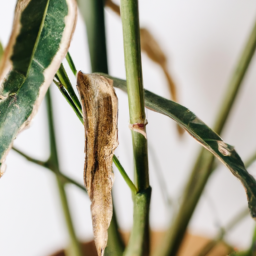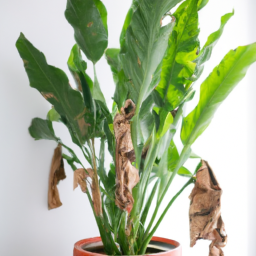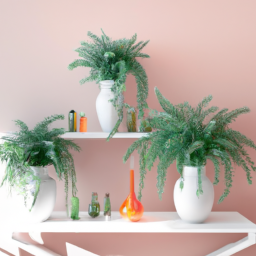
Have you ever noticed that your indoor plants are starting to turn brown? It can be frustrating and disheartening to see your once vibrant green plants fading away. In this blog post, we will explore the reasons behind why indoor plants turn brown and what you can do to prevent it from happening. So, if you’re wondering “Why indoor plants turn brown,” keep reading to find out how to keep your plants happy and healthy.
Common Reasons Why Indoor Plants Turn Brown
As an expert in indoor plants, I have seen many cases where plant owners are puzzled as to why their beloved greenery is turning brown. There are several common reasons why indoor plants may start to brown, and it’s important to understand these factors in order to prevent further damage and help your plants thrive. In this article, I will delve into the main culprits behind browning indoor plants and provide you with some practical tips on how to address these issues.
1. Lack of Proper Watering
One of the most common reasons why indoor plants turn brown is due to improper watering. Overwatering or underwatering can both lead to stress on the plant, causing the leaves to turn brown and wilt. It’s important to find the right balance when it comes to watering your indoor plants. Make sure to check the soil moisture regularly and water the plant only when the top inch of soil feels dry to the touch. Avoid letting the plant sit in water for extended periods of time, as this can lead to root rot and other issues.
In addition, the type of water you use can also impact the health of your indoor plants. Some plants are sensitive to chemicals in tap water, so using filtered or distilled water may be beneficial. Be mindful of the temperature of the water as well, as cold water can shock the plant’s roots. Overall, maintaining a consistent watering schedule and using the right type of water can help prevent browning due to water stress.
Lastly, humidity levels in your home can also affect the moisture levels in the soil and the plant itself. Some plants require higher humidity levels to thrive, so consider using a humidifier or placing a water tray near the plant to increase moisture in the air. Monitoring the humidity in your home can help prevent browning caused by dry air.
2. Lack of Proper Light
Another common reason why indoor plants turn brown is due to a lack of proper light. Plants need sunlight to photosynthesize and produce energy, so insufficient light can lead to browning and yellowing of leaves. Different plants have varying light requirements, so it’s important to research the specific needs of your indoor plants and place them in an appropriate location.
If your plant is not receiving enough light, consider moving it to a brighter spot or supplementing with artificial grow lights. Avoid placing the plant in direct sunlight, as this can lead to sunburn and further damage. Regularly rotate the plant to ensure all sides receive adequate light and prevent uneven browning.
In addition, be mindful of temperature fluctuations near windows or drafty areas, as this can also stress the plant and lead to browning. Maintaining a consistent temperature and light exposure can help prevent browning caused by light deficiency.
3. Lack of Proper Nutrients
Lastly, indoor plants may turn brown due to a lack of proper nutrients in the soil. Plants require essential nutrients such as nitrogen, phosphorus, and potassium to grow and thrive. If the soil is depleted of these nutrients, the plant may exhibit signs of nutrient deficiency, including browning of leaves.
To ensure your indoor plants are receiving adequate nutrients, consider using a balanced fertilizer specifically formulated for houseplants. Follow the instructions on the fertilizer package and avoid over-fertilizing, as this can lead to nutrient imbalances and further damage. Regularly check the soil pH and nutrient levels to ensure the plant is receiving the right amount of nutrients.
In addition, periodically repotting your indoor plants with fresh soil can help replenish nutrients and promote healthy growth. Be sure to choose a well-draining potting mix that is rich in organic matter to provide the plant with the necessary nutrients and support root health.
By addressing these common reasons why indoor plants turn brown, you can help your green companions thrive and enjoy their lush beauty for years to come. Remember to observe your plants closely, make adjustments as needed, and provide them with the care and attention they deserve. With proper watering, lighting, and nutrients, you can prevent browning and create a healthy indoor garden that brings joy and tranquility to your home.

Why Indoor Plants Turn Brown
Welcome to our guide on why indoor plants turn brown. As an expert in plant care, I’m here to provide you with valuable insights on this common issue. Indoor plants can add beauty and freshness to your home, but when they start turning brown, it can be frustrating. Let’s delve into the reasons behind this problem and how you can prevent it from happening.
Insufficient Light
One of the main reasons why indoor plants turn brown is due to insufficient light. Plants need adequate light to photosynthesize and thrive. If your plant is not getting enough light, it may start turning brown as a result. This is because the plant is unable to produce enough energy to sustain its growth and health.
To prevent this issue, make sure to place your indoor plants in a location where they can receive sufficient natural light. If your home doesn’t have enough natural light, consider using artificial grow lights to supplement the light requirements of your plants. Additionally, regularly rotate your plants to ensure all sides receive equal light exposure.
Another factor to consider is the type of plant you have. Some plants require more light than others, so it’s essential to research the specific light requirements of your indoor plants and adjust their placement accordingly.
Improper Watering
Overwatering or underwatering your indoor plants can also lead to browning leaves. When you overwater your plants, the roots may become waterlogged, leading to root rot and browning of the leaves. On the other hand, underwatering can cause the plant to become dehydrated, resulting in brown and crispy leaves.
To prevent this issue, make sure to water your plants according to their specific needs. Check the soil moisture before watering and adjust your watering schedule based on the plant’s requirements. Ensure proper drainage in your plant pots to prevent waterlogging and root rot. Consider using a moisture meter to accurately determine when your plants need watering.
Additionally, humidity levels in your home can also affect the watering needs of your indoor plants. Some plants require higher humidity levels, so consider using a humidifier or pebble tray to increase the humidity around your plants.
Pest Infestation
Pest infestations can also cause indoor plants to turn brown. Common pests such as spider mites, mealybugs, and aphids can damage the leaves and stems of your plants, leading to browning and wilting. If you notice any signs of pest infestation, such as webbing, sticky residue, or tiny insects on your plants, take immediate action to address the issue.
To prevent pest infestations, regularly inspect your indoor plants for any signs of pests. Quarantine new plants before introducing them to your existing collection to prevent the spread of pests. Consider using natural remedies or insecticidal soaps to control pest populations on your plants.
Proper plant maintenance, including regular pruning, cleaning, and monitoring, can help prevent pest infestations and keep your indoor plants healthy and vibrant.

Understanding Why Indoor Plants Turn Brown
1. Lack of Water
One of the most common reasons why indoor plants turn brown is due to a lack of water. Plants need water to survive, and when they don’t receive enough, they can become dehydrated. This can cause their leaves to turn brown and dry out. It’s important to water your indoor plants regularly, making sure not to overwater or underwater them.
One way to tell if your plant needs water is by checking the soil. Stick your finger into the soil about an inch deep. If it feels dry, it’s time to water your plant. Be sure to water thoroughly, allowing the water to drain out of the bottom of the pot.
In addition to regular watering, some plants may benefit from increased humidity. You can mist your plant’s leaves with water or place a humidifier nearby to help increase the moisture in the air.
2. Lack of Light
Another common reason for indoor plants turning brown is a lack of light. Plants need sunlight to photosynthesize and grow. If your plant is not receiving enough light, it may start to show signs of stress, such as browning leaves.
Make sure to place your indoor plants in a location where they can receive adequate sunlight. Different plants have different light requirements, so be sure to research the specific needs of your plant. If natural light is limited in your home, you can supplement with grow lights to help your plants thrive.
Rotate your plants regularly to ensure that all sides receive equal sunlight. This will help prevent one side from becoming brown and sunburned while the other side remains healthy.
3. Pests and Diseases
Pests and diseases can also cause indoor plants to turn brown. Common pests that can affect indoor plants include spider mites, aphids, and mealybugs. These pests can suck the sap from plants, causing them to wilt and turn brown.
To prevent pests, make sure to regularly inspect your plants for any signs of infestation. If you do find pests, you can try using insecticidal soap or neem oil to get rid of them. It’s also important to quarantine any new plants before introducing them to your existing collection to prevent the spread of pests.
In addition to pests, diseases such as fungal infections can also cause indoor plants to turn brown. Make sure to provide good air circulation around your plants and avoid overwatering, as excess moisture can promote the growth of fungi.
Here’s what we learned
Have you ever noticed that your indoor plants start to turn brown and wilt despite your best efforts to care for them? It can be frustrating to see your greenery lose its vibrant color and health, but there are several common reasons why this might be happening. One possible cause is overwatering – when plants receive too much water, their roots can become waterlogged and suffocate, leading to browning and wilting leaves. To prevent this, make sure to let the soil dry out between waterings and ensure that your pots have proper drainage to prevent water from pooling at the bottom.
Another reason why indoor plants might turn brown is due to inadequate lighting. Plants need sunlight to photosynthesize and thrive, so if they are not receiving enough light, they may start to lose their green color and turn brown. To remedy this, try moving your plants to a sunnier spot in your home or consider investing in a grow light to supplement their light intake. By addressing these common issues, you can help your indoor plants stay healthy and vibrant for years to come.
FAQ Compilation:
Q1: Why do indoor plants turn brown?
A1: Indoor plants can turn brown due to a variety of reasons, including overwatering, underwatering, inadequate light, low humidity, pests, or diseases. It’s important to identify the specific cause in order to address the issue effectively.
Q2: How can I prevent my indoor plants from turning brown?
A2: To prevent indoor plants from turning brown, make sure to properly water them by checking the soil moisture levels, provide adequate light based on the plant’s requirements, maintain proper humidity levels, regularly inspect for pests, and ensure good air circulation around the plant.
Q3: What should I do if my indoor plant is already turning brown?
A3: If your indoor plant is already turning brown, try to identify the specific cause by examining the plant’s environment and care routine. Adjust watering, lighting, and humidity levels accordingly. Trim off any dead or brown leaves, and consider repotting the plant if necessary.
Q4: Can indoor plants recover from turning brown?
A4: In many cases, indoor plants can recover from turning brown with proper care and attention. By addressing the underlying issue causing the browning, adjusting care routines, and providing a suitable environment, plants can often bounce back and regain their health.
Q5: When should I seek professional help for my indoor plant turning brown?
A5: If despite your efforts, your indoor plant continues to turn brown or deteriorate, it may be time to seek professional help. A plant expert or horticulturist can help diagnose the issue, provide guidance on treatment, and offer solutions to revive your plant.
Dr. Olivia Green is a botanist with over two decades of experience in indoor plant cultivation. She holds a Ph.D. in Plant Biology and has dedicated her career to researching plant behavior in controlled environments. Dr. Green is passionate about helping plant enthusiasts master the art of indoor gardening through her extensive knowledge and practical insights.


